Looking at the prospects for seeing the latest interstellar visitor to our solar system for yourself.
It’s the question of the hour. On the first day of the month July 1st, the Asteroid Terrestrial-impact Last Alert System (ATLAS) station at Río Hurtado, Chile spotted an interstellar interloper, which would receive the official designation C/2025 N1 ATLAS or 3I/ATLAS. The ‘I’ is a rare ‘interstellar’ designation, only the third such object known of after 1I/ʻOumuamua and 2/I Borisov.
But can we see it? Such a spectacle as actually seeing an interstellar comet would be a true rarity to cross off your skywatching life list.
A caveat is in order: part of the thrill of spotting 3I/ATLAS is knowing just what you’re seeing: similar to seeing the faint moons of Uranus or Neptune or a distant +14th magnitude quasar, 3I/ATLAS will never appear as much more than a fuzzy dot.
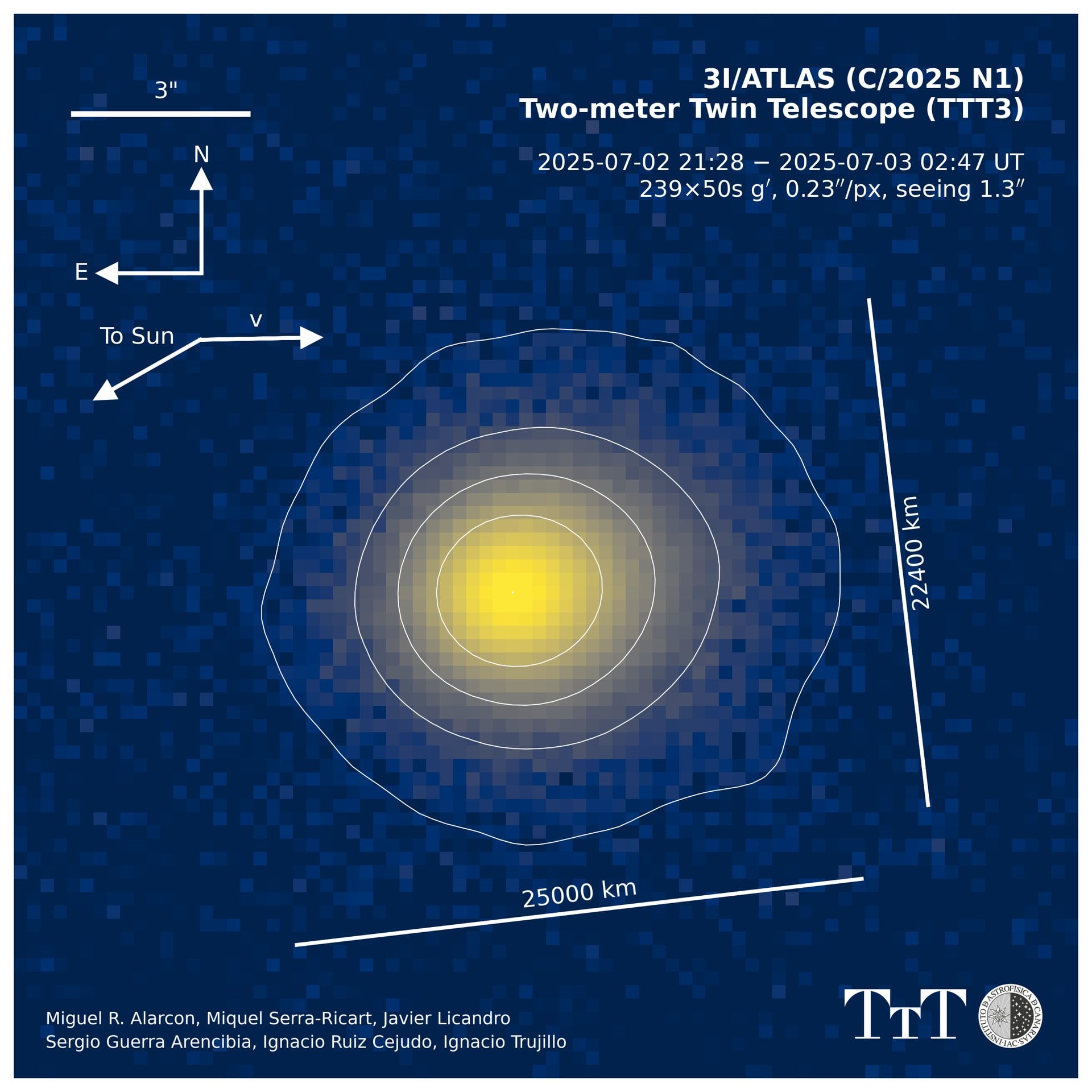 A close in look at Comet 3I/ATLAS, courtesy of the Two-Meter Twin Telescope. Credit: The TtT/Alarcon et al.
A close in look at Comet 3I/ATLAS, courtesy of the Two-Meter Twin Telescope. Credit: The TtT/Alarcon et al.
It’s amazing we caught sight of 3I/ATLAS at all; currently at over 4.2 Astronomical Units (AU) from the Sun just interior of the orbit of the planet Jupiter, the comet is only an +18th magnitude smudge on the border of the constellations Sagittarius and Ophiuchus. this is right along a star-rich stretch of the galactic plane, another reason it's currently tough to spot.
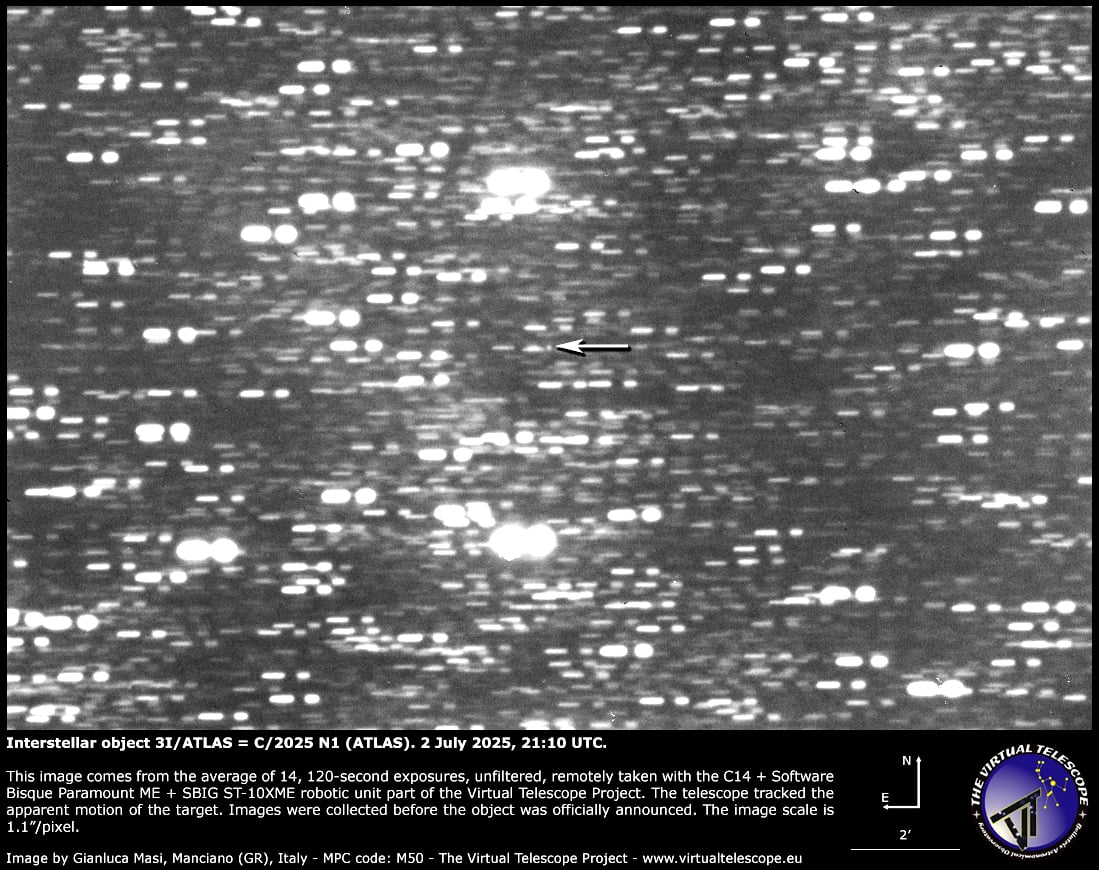 You can see just how crowded the star field along the galactic plane is, in this image of Comet 3I/ATLAS courtesy of the Virtual Telescope Project. Credit: Gianluca Masi.
You can see just how crowded the star field along the galactic plane is, in this image of Comet 3I/ATLAS courtesy of the Virtual Telescope Project. Credit: Gianluca Masi.
First the bad news: 3I/ATLAS won’t get much brighter than +11th magnitude as seen from the Earth… you’ll need a good-sized backyard telescope to pick it out. To top this off, it’ll really be truckin’ at 61 kilometers per second on its passage through the inner solar system. That speed would cover the span from the Earth to the Moon in just under two hours. 3I/ATLAS reaches perihelion nearly opposite to the Earth on the farside of the Sun.
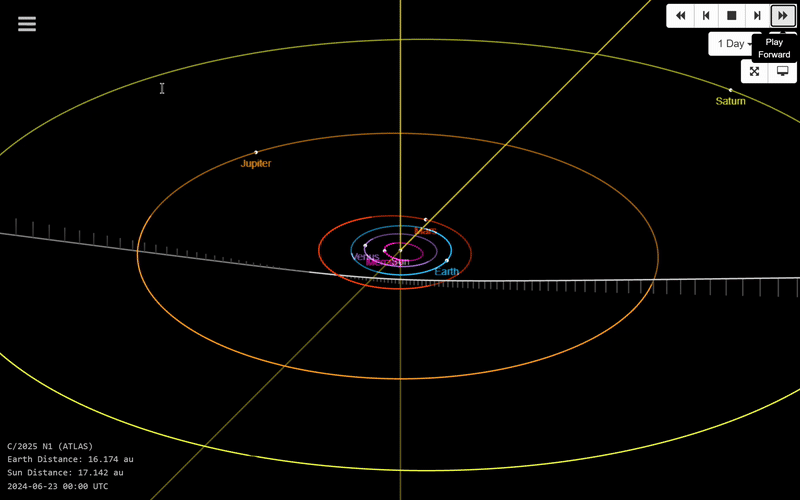 The speedy passage of Comet 3I/ATLAS through the inner solar system. Credit: NASA/JPL
The speedy passage of Comet 3I/ATLAS through the inner solar system. Credit: NASA/JPL
The comet is on an orbit inclined 175 degrees, that sees it run roughly along the ecliptic plane inbound.
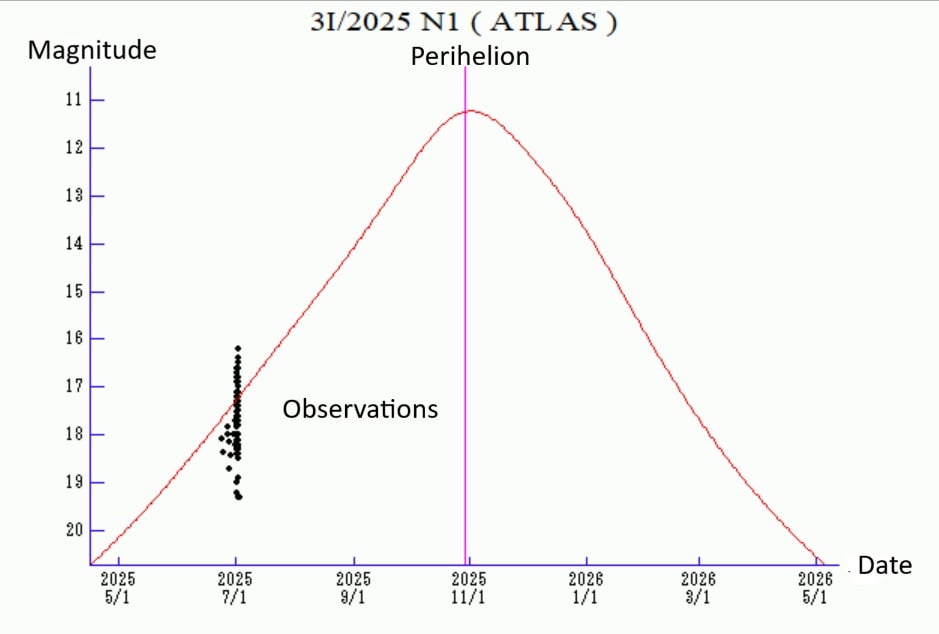 The projected light curve for Comet 3I/ATLAS. Credit: Adapted from Seiichi Yoshida's Weekly Information About Bright Comets.
The projected light curve for Comet 3I/ATLAS. Credit: Adapted from Seiichi Yoshida's Weekly Information About Bright Comets.
3I/ATLAS reaches perihelion on October 29th, at 1.36 AU from the Sun. Unfortunately, it will also sit only 18 degrees west of the Sun as seen from Earth on that date. It couldn’t have come through the inner solar system in a more inopportune season, in terms of the position of the Earth versus observation.
I3/ATLAS will be bashful leading up to perihelion, crossing through the zodiacal constellations of Ophiuchus, Scorpius, Libra and Virgo in the dusk sky in July through October.
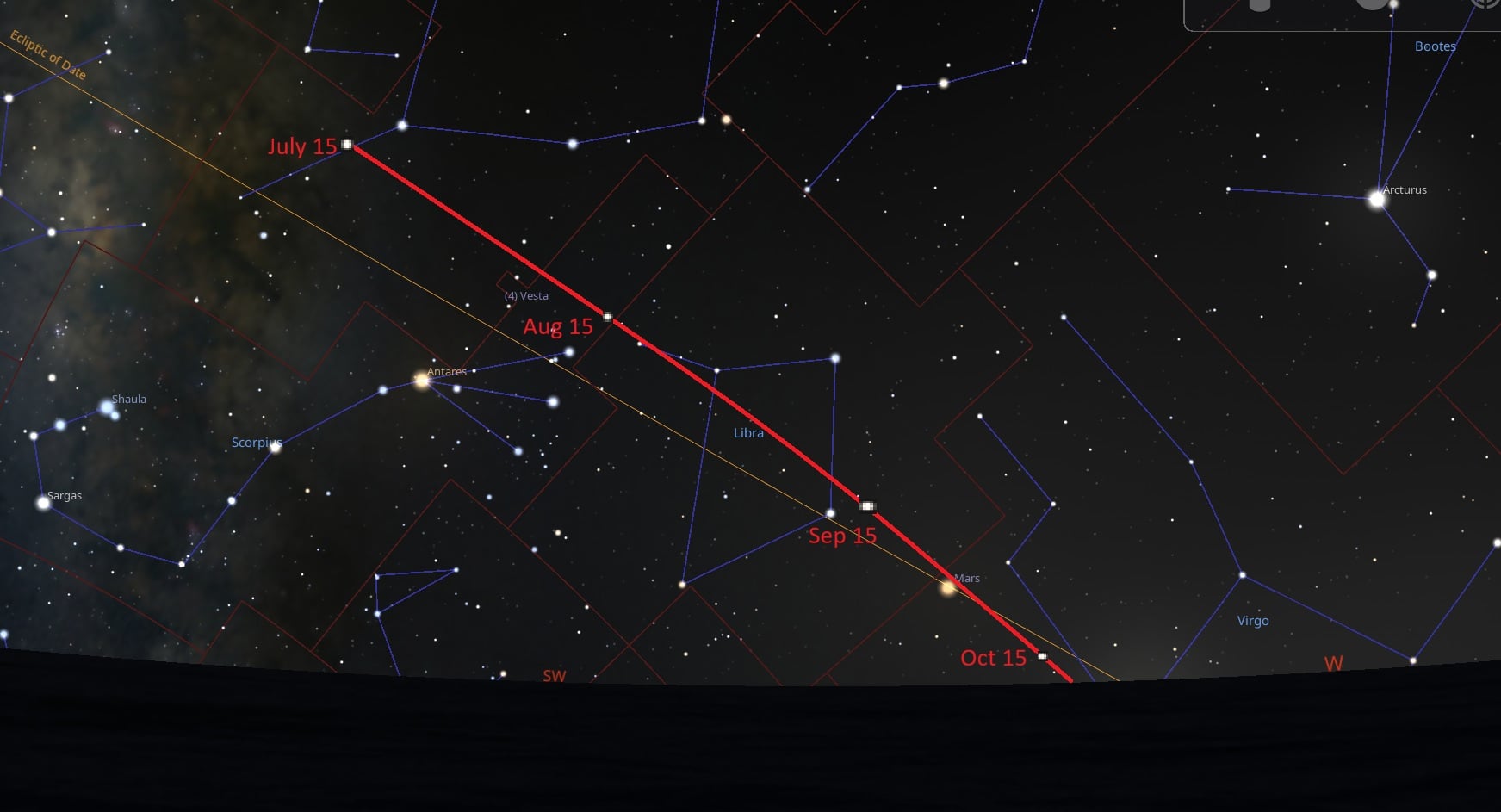 The dusk passage of Comet 3I ATLAS, leading up to perihelion. Credit: Stellarium.
The dusk passage of Comet 3I ATLAS, leading up to perihelion. Credit: Stellarium.
Prospects get better after perihelion outbound, as 3I/ATLAS continues through Virgo into Leo at dawn from October through December. Keep in mind, 3I/ATLAS is a dynamically new object—it has been in the frozen depths of deep space for millions of years—so it’s entirely possible that an outburst could brighten it up ahead of expectations as it nears the Sun. On the flip side, it could also disintegrate on approach as it's exposed to the heat of the Sun.
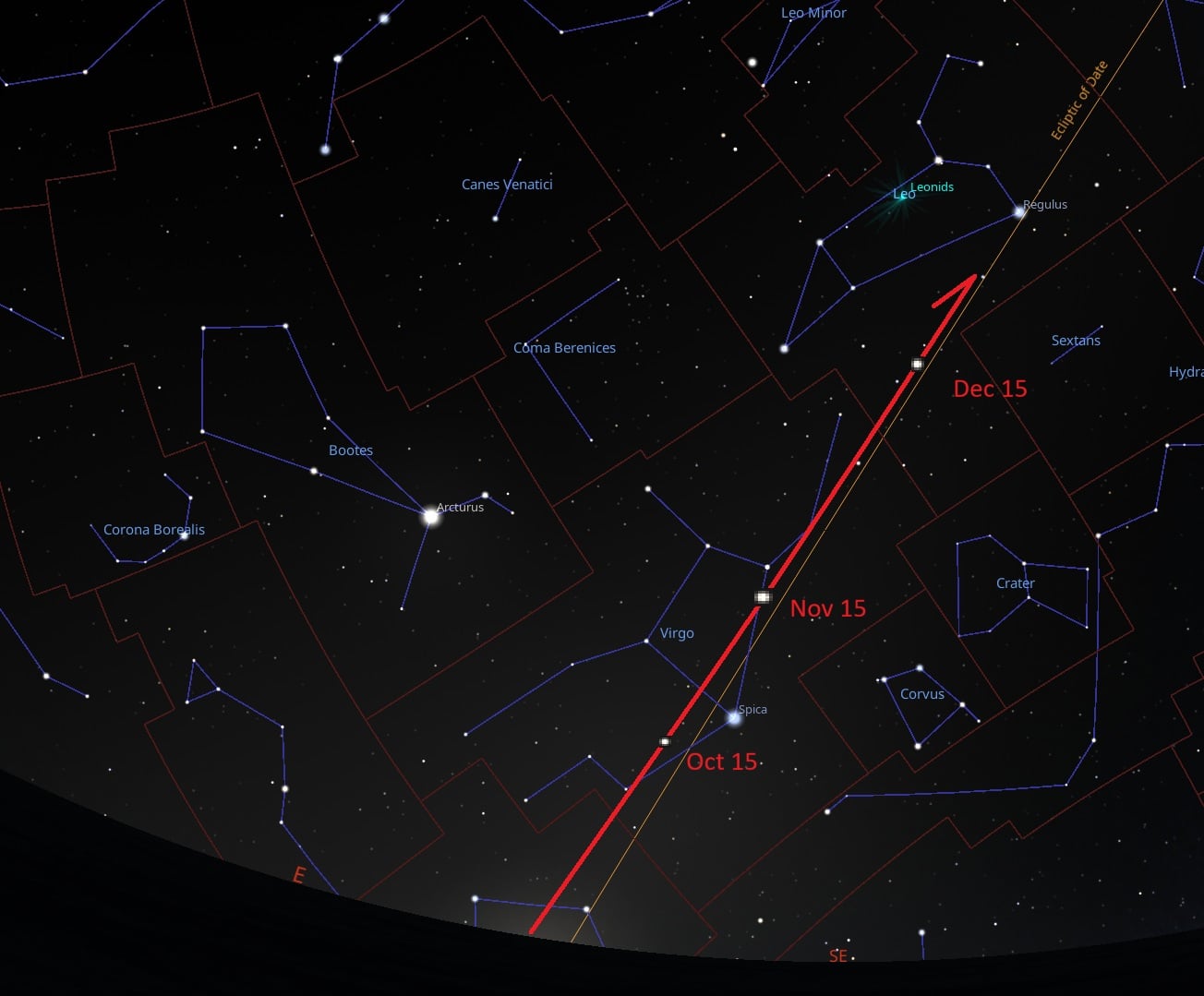 The 2025 dawn apparition of Comet 3I/ATLAS, post-perihelion. Credit: Stellarium.
The 2025 dawn apparition of Comet 3I/ATLAS, post-perihelion. Credit: Stellarium.
A close pass near Mars on October 3rd is certainly intriguing, and assets like the Mars Reconnaissance Orbiter (MRO) could in principle be re-tasked to image the comet. For planetary and spacecraft prospects versus 3I/ATLAS, we see:
-Passes 0.2 AU from Mars on October 3rd. -Passes 1.8 AU from Earth on December 19th. -Passes 0.33 AU from Jupiter on March 26, 2026.
For spacecraft across the solar system, we see:
-Passes 0.3 AU from Psyche on September 4th. -Passes 0.4 AU from JUICE on November 4th.
Finding 3I/ATLAS for yourself will require a large aperture or smartscope imager that can ‘go deep,’ and patience. I’d use NASA’s JPL Horizons ephemeris generator to plot 3I/ATLAS’s exact position in Right Ascension and declination, and image or visually scour the target region versus background stars for something slowly moving over the span of several nights. Comet 3I/ATLAS will be moving just under an apparent degree a day (twice the diameter of a Full Moon) across the sky during closest Earth approach in mid-December. The Comet Observer’s Database has current brightness estimates from observations, and Visual Comets has updated finder charts suitable to fine field comet hunting.
Observations carried out by the MUSE instrument on the Very Large Telescope on July 3rd suggest that 3I/ATLAS is a very red object, similar to Centaur populations or Trans-Neptunian Objects such as 486958 Arrokoth. Early estimates place the nucleus size of the comet at up to 24 kilometers across… but keep in mind, that’s currently an upper limit estimate for a faint object still a good ways out. 2I/Borisov also 'shrank' in terms of estimates for its nucleus size as more observations were made.
"Interstellar comet 3I/ATLAS exhibits an active appearance and colors similar to some solar system objects," says Astronomer Bryce Bolin (Eureka Scientific) in a recent paper on the comet based on observations. "While it is difficult to speculate on the size of 3I due to the coma obscuring the nucleus, future high-resolution observations will provide a better test of its size than ground-based, seeing-limited observations can"
It’s likely that, in earlier times (like, say, even just a decade or so ago), an object like 3I/ATLAS would’ve zipped through the solar system entirely unnoticed. The discovery shows that we’re getting better at spotting faint fuzzies, as a new generation of sky surveys reveals a hidden population of interstellar asteroids and comets passing through the solar system.

